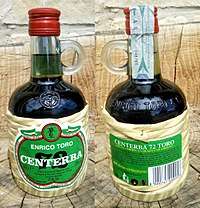Centerbe
Centerbe [ˌtʃɛnˈtɛrbe] or Centerba (italian for "one hundred herbs"), is a liqueur made by aromatic herbs commonly found on Mount Majella.[1][2] It is a typical abruzzese liquor in central Italy and it's made on a base of 70% alcohol.[1][3] The liqueur comes in two strengths: strong and mild. The strong centerba is widely used as digestif after-meals and has antiseptic properties.[4] It was originally manufactured by Beniamino Toro in Tocco da Casauria in 1817.[4][5]
 | |
| Type | Amaro (liqueur) |
|---|---|
| Country of origin | Mount Majella, Italy |
| Introduced | 1817 |
| Alcohol by volume | 75% |
It's usually made with 60 to 150 proof (30–75%) alcohol by volume, and can be made by placing orange leaves, basil, chamomile, rosemary, sage, juniper, cloves, cinnamon, toasted coffee beans, saffron, mint, lemon leaves, mandarin leaves, thyme blossoms, and marjoram in a bottle.
'White Unsweetened Centerbe' is an ingredient in the forgotten (presumably French) Coup de Foudre ['Love Struck'] cocktail, included in the United Kingdom Bartenders Guild's '1700 Cocktails' (1934). Verbatim, the recipe is: 1/3 White Unsweetened Centerbe', 1/3 Red Curaçao, 1/3 Coates Plymouth Gin. Serve with a small piece of candied orange peel.
'Unsweetened' suggests that, at that time, a strictly medicinal version of Centerbe was available, perhaps similar to the homemade recipe above without the sugar syrup. Alternatively, many of the 18th century sweet recipes are, to modern tastes, exceptionally sweet. So perhaps standard Centerbe was routinely sweetened to make it palatable. Bols and Grand Marnier both formerly made red curacaos. Coates, then owners of Plymouth Gin, subsidised the publication of 1700, and in return became the 'named' gin brand in almost all the recipes.
References
- Italy By Matthew Evans p.100
- Style and social identities: alternative approaches to linguistic heterogeneity By Peter Auer p.74
- College of Health and Human Sciences, Oregon State University Archived July 18, 2011, at the Wayback Machine
- Official catalogue By Dublin international exhibition, 1865 p.34 #156 Google Books
- The Technologist Ed. by P.L. Simmonds edited by Peter Lund Simmonds p.40